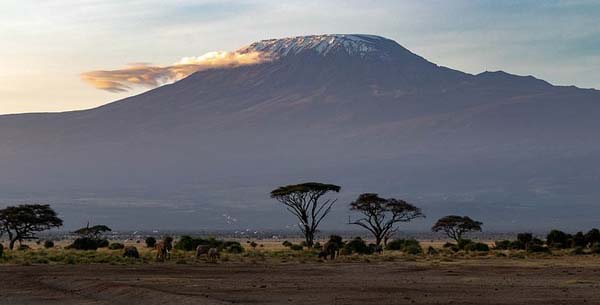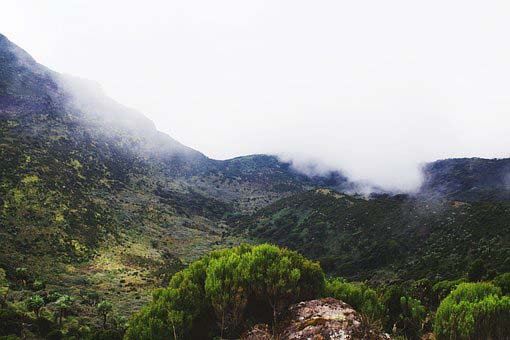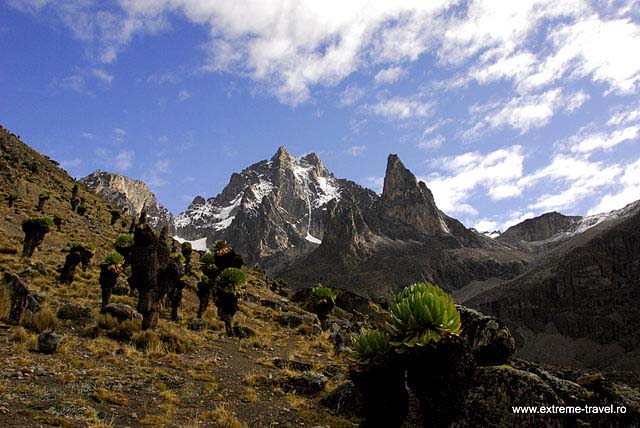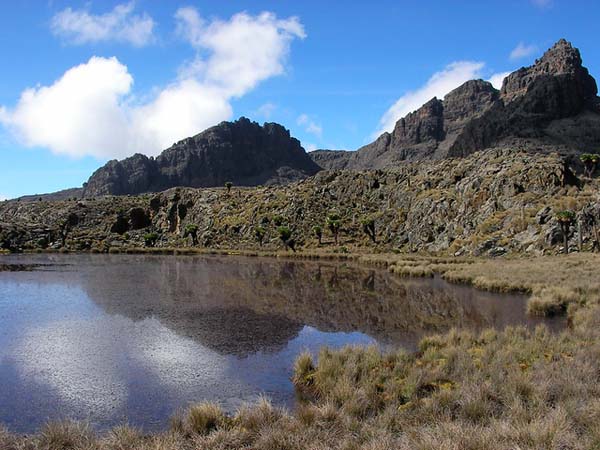Mt
Kenya Climbing - Kenya trekking, Kenya Mount Organized Treks
by Robert Muhoho
If time is limited or you'd
prefer someone else to make all the trekking arrangements, there are plenty
of possibilities. It is hard to go anywhere in this region without being
approached by several prospective guides. all-inclusive packages - which
include park entry and camping fees, food, huts, a guide, a cook and porters,
and transfers to and from the mountain can be a good deal, particularly
if you don't have any equipment.

As always, you need to watch
out for sharks; picking the right company is even more important here as
on a normal wildlife safari, as an unqualified or inexperienced guide could
put you in very real danger as well as spoil your trip.
Responsible Trekking on Mount
Kenya
Mt Kenya's trekking popularity
is placing great pressure on the environment. You can help preserve the
ecology and beauty of the area by taking note of the following information.
-
Carry out all your rubbish.
Never bury it.
-
Minimize the waste you must
carry by taking minimal packaging and no more food than you'll need.
-
Where there is no toilet, at
lower elevations, bury your faeces in a 15 cm deep hole (consider carrying
a lightweight towel for this purpose). At higher altitudes soil lacks the
organisms to needed to digest your faeces, so leave your waste in the open
where UV rays will break it down Ėspreading it facilitates the process.
always carry out your toilet paper (zip lock bags are best). with either
option make sure your faeces are at least 50m from any path, 100m from
any watercourse and 200m from any building.
-
Don't use detergents or toothpaste
within 50 m of watercourses, even if they are biodegradable.
-
Stick to existing tracks and
avoid short cuts that bypass a switchback. If you blaze a new trail straight
down a slope, it will erode the hillside with the next rainfall.
-
Avoid removing plant life, as
it keeps topsoil in place.
-
Open fires aren't permitted
.cook on lightweight kerosene, alcohol or Shellite (white gas) stoves.
-
Never feed the wildlife, as
it messes with their digestive system and leads them to become dependent
on hand-outs.
-
If camping, try camping on existing
sites. Where none exist, set up away from streams on rock or bare ground,
never over vegetation.

Naro Moru River Lodge
(Naro Moru.) Also runs a range
of all inclusive trips. Its prices are more expensive than most, but it
is the only company that can guarantee you beds at the Met Station Hut
and Mackinderís Camp.
On the Naro Moru route.
There are several Safari companies
in Nairobi that offer Mt Kenya treks ,but many just sell the treks operated
by Naro Moru and Mountain Rock Lodges, charging you an extra commission
on top. Companies that do run their own treks include the following.
Into Africa
this environmentally and culturally
sensitive company places an emphasis on fair trade and offers both scheduled
and exclusive seven day trips (six days of trekking) ascending Sirimon
route and descending Chogoria. Joining scheduled
trips cost US$ 180 per day (minimum two people), while private treks
range from US$ 150 to US$ 256 per person per day, depending on group size.
Top
|
Kenya
Mt Climb Guide, Information and Facts - Climbing Kenya Mountain
by Robert Muhoho
Clothing & Equipment
Seeing that Mt Kenyaís summit
are surrounded by glaciers and often covered by snow, you should be surprised
to hear that nightly temperatures often drop to below -10 c (it certainly
feels like it in Mackinders hut), so bring a good sleeping bag. A closed
cell foam mat or thermarest is also vital for insulation if you are camping.
A good set of warm clothes (wools or synthetic-never cotton, as it traps
moisture) including quality head gear and gloves, is equally important
as it can rain heavily at any time of year, you will also need waterproof
clothing (breathing fabric like Gore-Tex is best).
While a descent pair of boots
isnít strictly necessary, hiking in sodden joggers isnít fun and neither
is losing your grip on wet or icy rocks near the summit .bringing a pair
of sandals or light shoes to wear in the evening when your boots get wet
is a good idea. At this altitude the sun can do some serious damage to
your skin and eyes, so sun bloc and sun glasses are also crucial items.
If a porter is carrying your backpack always keep essential clothing (warm
and wet weather gear) in your day-pack because you may become separated
for hours at a time.

Itís not a good idea to sleep
in clothes youíve worn during the day because the sweat absorbed keeps
them moist at night, reducing their heat-retention capabilities. If you
donít intend to stay in the huts along the way, youíll also need a tent
and related equipment.
You will also need a stove,
basic equipment, utensils, a 3L water container (per person) and water
purifying tablets. Stove fuel in form of petrol and kerosene (paraffin)
is fairly easily found in towns, and methylated spirits, is available in
Nairobi, as are gas cartridges, although the supply of this isnít guaranteed.
Fires are prohibited in the
open unless there is an emergency; in any case, there is no wood once you
get beyond 3300m. If you engage porters, youíll have to supply each of
them with a backpack to carry your gear and theirs.
If you have a mobile phone,
take it along suitably protected of course; reception on the mountainís
higher reaches is actually very good, and a link to the outside world is
invaluable during emergency.
Kenya Mountain Climbing Equipment
hire
Well maintained rental gear
is available at the Naro Moru River Lodge (P.O. box 18, Naro Moru), a although
it cant be reserved and is relatively expensive, (US$4 per day for a sleeping
bag). Most guiding companies will have cheaper equipment for hire, although
you will have less choice for lower standards.

Guides, Cooks & Porters
Taking on a guide and a porter
will improve your chances of getting to the top and avoiding altitude sickness.
For starters, having a porter carrying your heavy gear is like traveling
in a chauffeured Mercedes instead of a matatu. A good guide will help you
set a sustainable pace and hopefully dispense interesting information about
Mt Kenya and its flora, fauna and its wildlife. With both on your team
your appreciation of this mountain will be enhanced a hundredfold and,
for the price it is a bargain.
If you hire a good guide
or porter who can also cook, youíll not regret it. itís one thing to arrive
at camp safe, sound and enlightened, but arriving to steaming coffee and
a hot meal is beyond nice - itís heaven.
Considerable effort has been
made in recent years to regulate guides and porters operating on the mountain.
The KWS now issues vouchers to all registered guides and porters, who should
also hold identity cards; they wonít be allowed into the park without them.
Female guides are becoming
more common, and technical guides for climbing Batian and Nelion are widely
available.
Top
|

